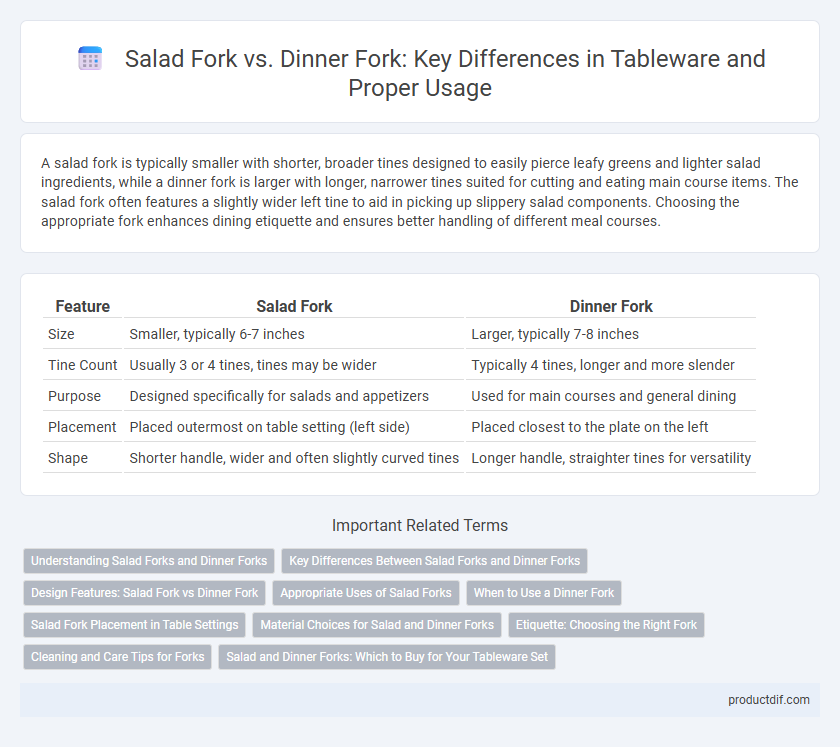A salad fork is typically smaller with shorter, broader tines designed to easily pierce leafy greens and lighter salad ingredients, while a dinner fork is larger with longer, narrower tines suited for cutting and eating main course items. The salad fork often features a slightly wider left tine to aid in picking up slippery salad components. Choosing the appropriate fork enhances dining etiquette and ensures better handling of different meal courses.
Table of Comparison
| Feature | Salad Fork | Dinner Fork |
|---|---|---|
| Size | Smaller, typically 6-7 inches | Larger, typically 7-8 inches |
| Tine Count | Usually 3 or 4 tines, tines may be wider | Typically 4 tines, longer and more slender |
| Purpose | Designed specifically for salads and appetizers | Used for main courses and general dining |
| Placement | Placed outermost on table setting (left side) | Placed closest to the plate on the left |
| Shape | Shorter handle, wider and often slightly curved tines | Longer handle, straighter tines for versatility |
Understanding Salad Forks and Dinner Forks
Salad forks are typically smaller than dinner forks, featuring a broader left tine designed to cut through leafy greens and vegetables with ease. Dinner forks are larger and more robust, intended for the main course and capable of handling a wide variety of foods, including meats and starches. Recognizing these differences enhances proper table setting and dining etiquette, ensuring each utensil serves its specific function efficiently.
Key Differences Between Salad Forks and Dinner Forks
Salad forks typically measure around 6 to 7 inches and feature broader, shorter tines designed for picking up leafy greens and delicate salad ingredients. Dinner forks are larger, usually 7 to 8 inches long, with longer, narrower tines suited for cutting and eating main course dishes. The weight and tine shape differences enhance usability, with salad forks offering better control over slippery salad items, while dinner forks provide more leverage for protein and heavier foods.
Design Features: Salad Fork vs Dinner Fork
Salad forks typically feature a shorter length and broader, flatter tines designed to easily spear and scoop leafy greens and small salad ingredients. Dinner forks are longer with more slender, evenly spaced tines optimized for cutting and eating main course dishes, providing greater versatility. The subtle differences in tine shape and fork size enhance their specific functional uses within formal and casual dining settings.
Appropriate Uses of Salad Forks
Salad forks are designed with shorter tines and a slightly broader curve to efficiently spear and scoop leafy greens and delicate vegetables, making them ideal for appetizers and side salads. Their smaller size compared to dinner forks allows for better control and precision when handling lighter, softer foods. Using salad forks appropriately enhances the dining experience by maintaining the proper etiquette and functionality during multi-course meals.
When to Use a Dinner Fork
A dinner fork is typically used during the main course and paired with heavier or more substantial dishes, such as roasted meats or pasta, where a larger fork provides better leverage and control. It is generally placed to the left of the plate, next to the salad fork, which is smaller and reserved for salads or appetizers. Opt for a dinner fork when the meal includes denser or heartier foods that require more robust utensil support for effective cutting and eating.
Salad Fork Placement in Table Settings
Salad forks are typically placed to the left of the dinner fork in formal table settings, emphasizing their use during the salad course served before the main meal. Their smaller size compared to dinner forks distinguishes their function, ensuring guests use the appropriate utensil in sequence. Proper placement enhances the dining experience by promoting etiquette and ease of use throughout multi-course meals.
Material Choices for Salad and Dinner Forks
Salad forks and dinner forks are commonly crafted from stainless steel, prized for its durability and resistance to corrosion, with higher-end options featuring sterling silver for enhanced elegance. Some salad forks incorporate softer materials like bamboo or recycled plastics, targeting eco-conscious consumers seeking sustainable tableware alternatives. Dinner forks generally emphasize sturdier, polished metals to withstand frequent use and maintain a formal dining aesthetic.
Etiquette: Choosing the Right Fork
Choosing the right fork for your meal reflects proper dining etiquette, where a salad fork is smaller with a broader left tine, specifically designed to handle leafy greens and appetizers. In contrast, a dinner fork is larger, sturdier, and used for the main course, providing better leverage for cutting and spearing proteins. Understanding these distinctions helps maintain table manners and enhances the dining experience in formal settings.
Cleaning and Care Tips for Forks
Proper cleaning and care of salad forks and dinner forks extend their longevity and maintain shine. Use warm, soapy water or a dishwasher with a gentle cycle, avoiding harsh detergents and abrasive scrubbers to prevent scratches. Dry forks immediately after washing with a soft cloth to prevent water spots and corrosion, especially for high-quality stainless steel or silver-plated pieces.
Salad and Dinner Forks: Which to Buy for Your Tableware Set
Salad forks typically feature a shorter length and broader tines designed for handling greens and lighter fare, making them ideal for appetizer courses. Dinner forks are larger with longer tines, suitable for main courses and versatile table settings. Choosing a set that includes both salad and dinner forks ensures functional versatility and enhances the overall dining experience.
Salad Fork vs Dinner Fork Infographic

 productdif.com
productdif.com